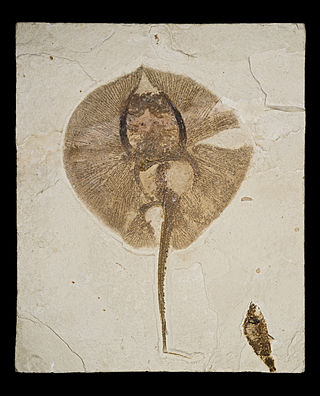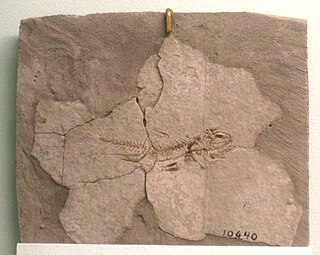
The Green River Formation is an Eocene geologic formation that records the sedimentation in a group of intermountain lakes in three basins along the present-day Green River in Colorado, Wyoming, and Utah. The sediments are deposited in very fine layers, a dark layer during the growing season and a light-hue inorganic layer in the dry season. Each pair of layers is called a varve and represents one year. The sediments of the Green River Formation present a continuous record of six million years. The mean thickness of a varve here is 0.18 mm, with a minimum thickness of 0.014 mm and maximum of 9.8 mm.

Knightia is an extinct genus of clupeid bony fish that lived in the freshwater lakes and rivers of North America and Asia during the Eocene epoch. The genus was erected by David Starr Jordan in 1907, in honor of the late University of Wyoming professor Wilbur Clinton Knight, "an indefatigable student of the paleontology of the Rocky Mountains." It is the official state fossil of Wyoming, and the most commonly excavated fossil fish in the world.

Fossil Butte National Monument is a United States National Monument managed by the National Park Service, located 15 miles (24 km) west of Kemmerer, Wyoming, United States. It centers on an assemblage of Eocene Epoch animal and plant fossils associated with Fossil Lake—the smallest lake of the three great lakes which were then present in what are now Wyoming, Utah, and Colorado. The other two lakes were Lake Gosiute and Lake Uinta. Fossil Butte National Monument was established as a national monument on October 23, 1972.
Driftwood Canyon Provincial Park is a provincial park in British Columbia, Canada. Driftwood Canyon Provincial Park covers 23 hectares of the Bulkley River Valley, on the east side of Driftwood Creek, a tributary of the Bulkley River, 10 km northeast of the town of Smithers. The park is accessible from Driftwood Road from Provincial Highway 16. It was created in 1967 by the donation of the land by the late Gordon Harvey (1913–1976) to protect fossil beds on the east side of Driftwood Creek. The beds were discovered around the beginning of the 20th century. The park lands are part of the asserted traditional territory of the Wet'suwet'en First Nation.

Heliobatis is an extinct genus of stingray in the Myliobatiformes family Dasyatidae. At present the genus contains the single species Heliobatis radians.

Amyzon is an extinct genus belonging to the sucker family Catostomidae first described in 1872 by E. D. Cope. There are six valid species in the genus. Amyzon are found in North American fossil sites dated from the Early Eocene in Montana and Washington USA, as well as the British Columbian sites at McAbee Fossil Beds, Driftwood Canyon, and the "Horsefly shale", as well as Early Oligocene sites in Nevada USA. One Middle Eocene species is known from the Xiawanpu Formation of China. The Ypresian species A. brevipinne of the Allenby Formation was redescribed in 2021 and moved to a separate monotypic genus Wilsonium.

Phareodus is a genus of freshwater fish from the Paleocene to Eocene of North America.
Orthogenysuchus is an extinct genus of caimanine alligatorids. Fossils have been found from the Wasatch Beds of the Willwood Formation of Wyoming, deposited during the early Eocene. The type species is O. olseni. The holotype, known as AMNH 5178, is the only known specimen belonging to the genus and consists of a skull lacking the lower jaws. The braincase is filled in by the matrix and most of the suture lines between bones are indiscernible, making comparisons with other eusuchian material difficult.
Neoephemera antiqua is an extinct species of square-gill mayfly in the family Neoephemeridae that is known from early Eocene, Ypresian stage, lake deposits near the small community of Republic in Ferry County, Washington, USA.

Bahndwivici is an extinct genus of lizard known from a nearly complete and articulated skeleton discovered in rocks of the Green River Formation of Wyoming, United States. The skeleton is very similar to that of the modern Chinese crocodile lizard, Shinisaurus.

Afairiguana avius is an extinct iguanid lizard known from a nearly complete and articulated skeleton discovered in rocks of the Early Eocene-aged Green River Formation of Wyoming, United States. As of the initial description, the skeleton represents the oldest complete iguanian from the Western Hemisphere, and is the oldest representative of the extant iguanid family of anoles, Polychrotidae.

Paleontology in Wyoming includes research into the prehistoric life of the U.S. state of Wyoming as well as investigations conducted by Wyomingite researchers and institutions into ancient life occurring elsewhere.

The Bridger Formation is a geologic formation in southwestern Wyoming. It preserves fossils dating back to the Bridgerian and Uintan stages of the Paleogene Period. The formation was named by American geologist Ferdinand Vandeveer Hayden for Fort Bridger, which had itself been named for mountain man Jim Bridger. The Bridger Wilderness covers much of the Bridger Formation's area.

Gyaclavator is an extinct genus of lace bug in the family Tingidae known from a fossil found in North America. The genus contains a single species, Gyaclavator kohlsi.

Hiodon woodruffi is an extinct species of bony fish in the mooneye family, Hiodontidae. The species is known from fossils found in the early Eocene deposits of northern Washington state in the United States and late Eocene deposits in northwestern Montana. The species was first described as Eohiodon woodruffi. H. woodruffi is one of two Eocene Okanagan Highlands mooneye species, and one of five fish identified in the Klondike Mountain Formation.

Amia? hesperia is an extinct species of ray-finned fish in the bowfin family, Amiidae. The species is known from fossils found in the early Eocene deposits of northern Washington state in the United States and southeastern British Columbia. The species is one of eight fish species identified in the Eocene Okanagan Highlands paleofauna.

Cockerellites is a genus of extinct temperate bass described from early Eocene-aged fossils found in the Green River Formation of Wyoming. It is characterized by a sunfish-like body and its stout dorsal and anal spines. The type species, C. liops, was originally named as a species of Priscacara by Edward Drinker Cope upon creating the genus in 1877, but P. liops was moved to the newly created genus Cockerellites by D. Jordan and H. Hanibal in 1923. Some authors, such as Whitlock (2010), still consider Cockerellites liops as a species of Priscacara.
The paleofauna of the Eocene Okanagan Highlands consists of Early Eocene arthropods, vertebrates, plus rare nematodes and molluscs found in geological formations of the northwestern North American Eocene Okanagan Highlands. The highlands lake bed series' as a whole are considered one of the great Canadian Lagerstätten. The paleofauna represents that of a late Ypresian upland temperate ecosystem immediately after the Paleocene-Eocene thermal maximum, and before the increased cooling of the middle and late Eocene to Oligocene. The fossiliferous deposits of the region were noted as early as 1873, with small amounts of systematic work happening in the 1880-90s on British Columbian sites, and 1920-30s for Washington sites. Focus and more detailed descriptive work on the Okanagan Highlands site started in the last 1970's. Most of the highlands sites are preserved as compression-impression fossils in "shales", but also includes a rare permineralized biota and an amber biota.

Libotonius is an extinct genus of percopsiform fish which lived during the early Eocene epoch and contains two species, the type species Libotonius blakeburnensis plus Libotonius pearsoni. Libotonius has been variously treated as part of the expanded Percopsidae family, or formerly as a member of the monotypic family Libotoniidae.

Erismatopterus is an extinct genus of percopsiform fish which lived during the early to middle Eocene epoch and containing the single species Erismatopterus levatus. A report of the genus in sediments of similar age in Washington State have been discredited. Erismatopterus is treated as part of the family Percopsidae, but formerly was the type genus of the extinct family Erismatopteridae. The genus is closely related to Amphiplaga of related lake sediments. Shoaling behavior has been reported from a mass mortality fossil of E. levatus and attributed as a predator-evasion response behavior.

















